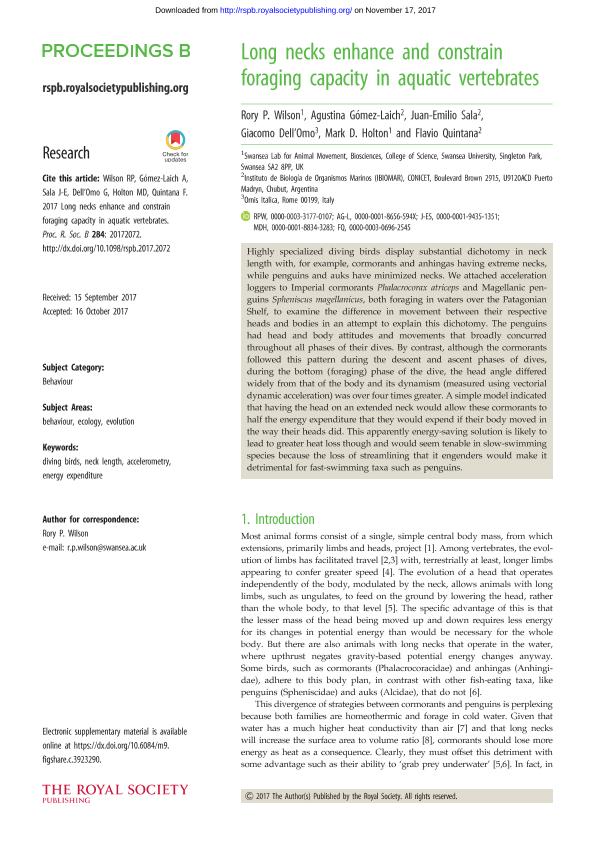Mostrar el registro sencillo del ítem
dc.contributor.author
Wilson, Rory P.

dc.contributor.author
Gómez Laich, Agustina Marta

dc.contributor.author
Sala, Juan Emilio

dc.contributor.author
Dell´Omo, Giacomo
dc.contributor.author
Holton, Mark

dc.contributor.author
Quintana, Flavio Roberto

dc.date.available
2018-02-28T18:52:12Z
dc.date.issued
2017-11
dc.identifier.citation
Wilson, Rory P.; Gómez Laich, Agustina Marta; Sala, Juan Emilio; Dell´Omo, Giacomo; Holton, Mark; et al.; Long necks enhance and constrain foraging capacity in aquatic vertebrates; The Royal Society; Proceedings of the Royal Society of London. Series B: Biological Sciences; 284; 1867; 11-2017; 1-8
dc.identifier.issn
0962-8452
dc.identifier.uri
http://hdl.handle.net/11336/37440
dc.description.abstract
Highly specialized diving birds display substantial dichotomy in neck length with, for example, cormorants and anhingas having extreme necks, while penguins and auks have minimized necks. We attached acceleration loggers to Imperial cormorants Phalacrocorax atriceps and Magellanic penguins Spheniscus magellanicus, both foraging in waters over the Patagonian Shelf, to examine the difference in movement between their respective heads and bodies in an attempt to explain this dichotomy. The penguins had head and body attitudes and movements that broadly concurred throughout all phases of their dives. By contrast, although the cormorants followed this pattern during the descent and ascent phases of dives, during the bottom (foraging) phase of the dive, the head angle differed widely from that of the body and its dynamism (measured using vectorial dynamic acceleration) was over four times greater. A simple model indicated that having the head on an extended neck would allow these cormorants to half the energy expenditure that they would expend if their body moved in the way their heads did. This apparently energy-saving solution is likely to lead to greater heat loss though and would seem tenable in slow-swimming species because the loss of streamlining that it engenders would make it detrimental for fast-swimming taxa such as penguins.
dc.format
application/pdf
dc.language.iso
eng
dc.publisher
The Royal Society

dc.rights
info:eu-repo/semantics/openAccess
dc.rights.uri
https://creativecommons.org/licenses/by-nc-sa/2.5/ar/
dc.subject
Accelerometry
dc.subject
Diving Birds
dc.subject
Energy Expenditure
dc.subject
Neck Length
dc.subject.classification
Otras Ciencias Biológicas

dc.subject.classification
Ciencias Biológicas

dc.subject.classification
CIENCIAS NATURALES Y EXACTAS

dc.title
Long necks enhance and constrain foraging capacity in aquatic vertebrates
dc.type
info:eu-repo/semantics/article
dc.type
info:ar-repo/semantics/artículo
dc.type
info:eu-repo/semantics/publishedVersion
dc.date.updated
2018-02-22T14:31:05Z
dc.journal.volume
284
dc.journal.number
1867
dc.journal.pagination
1-8
dc.journal.pais
Reino Unido

dc.journal.ciudad
Londres
dc.description.fil
Fil: Wilson, Rory P.. Swansea University; Reino Unido
dc.description.fil
Fil: Gómez Laich, Agustina Marta. Consejo Nacional de Investigaciones Científicas y Técnicas. Centro Científico Tecnológico Conicet - Centro Nacional Patagónico. Instituto de Biología de Organismos Marinos; Argentina
dc.description.fil
Fil: Sala, Juan Emilio. Consejo Nacional de Investigaciones Científicas y Técnicas. Centro Científico Tecnológico Conicet - Centro Nacional Patagónico. Instituto de Biología de Organismos Marinos; Argentina
dc.description.fil
Fil: Dell´Omo, Giacomo. Ornis Italica; Italia
dc.description.fil
Fil: Holton, Mark. Swansea University; Reino Unido
dc.description.fil
Fil: Quintana, Flavio Roberto. Consejo Nacional de Investigaciones Científicas y Técnicas. Centro Científico Tecnológico Conicet - Centro Nacional Patagónico. Instituto de Biología de Organismos Marinos; Argentina
dc.journal.title
Proceedings of the Royal Society of London. Series B: Biological Sciences

dc.relation.alternativeid
info:eu-repo/semantics/altIdentifier/doi/http://dx.doi.org/10.1098/rspb.2017.2072
dc.relation.alternativeid
info:eu-repo/semantics/altIdentifier/url/http://rspb.royalsocietypublishing.org/content/284/1867/20172072
Archivos asociados
